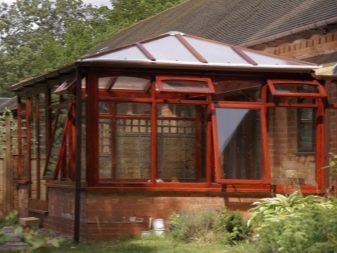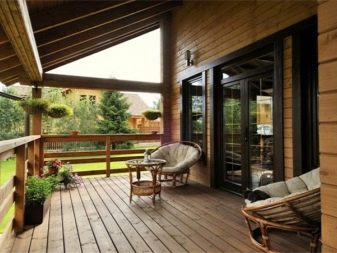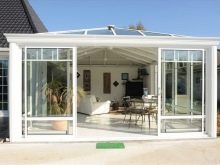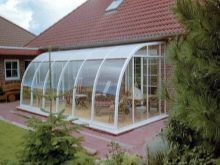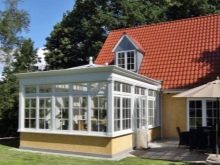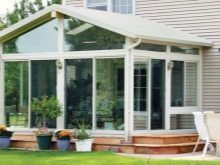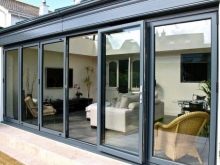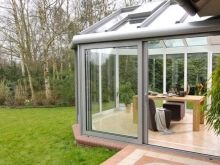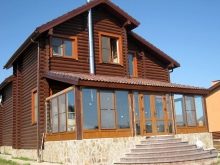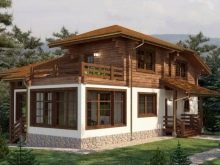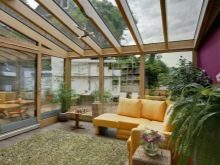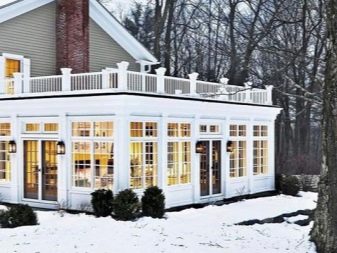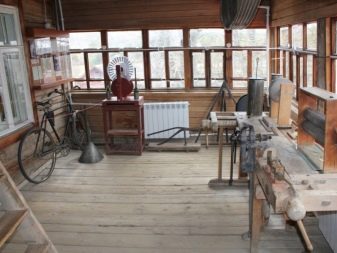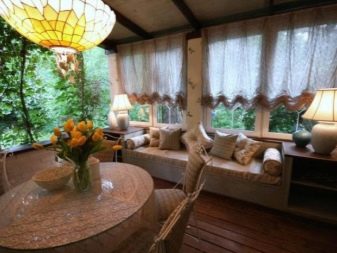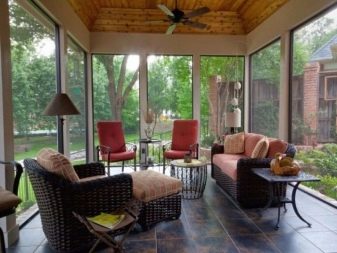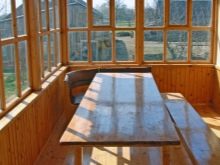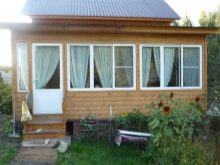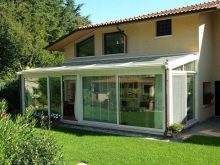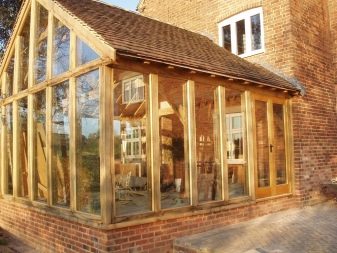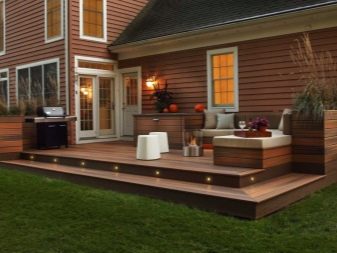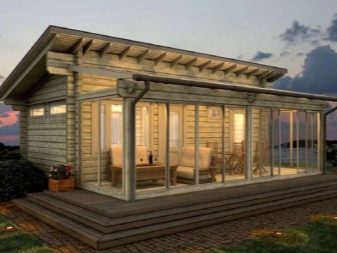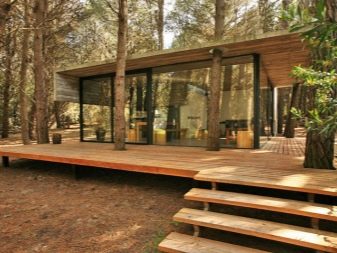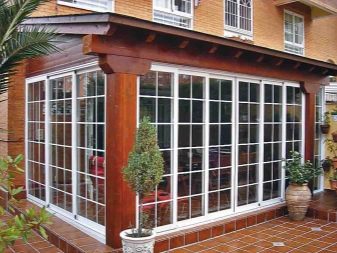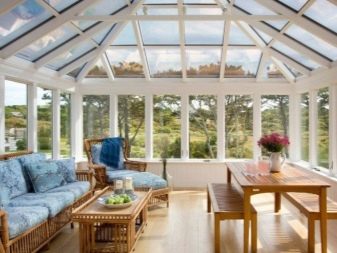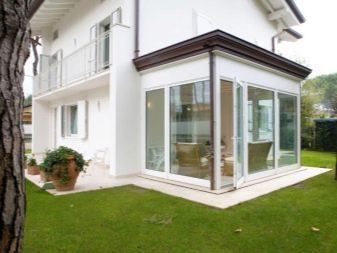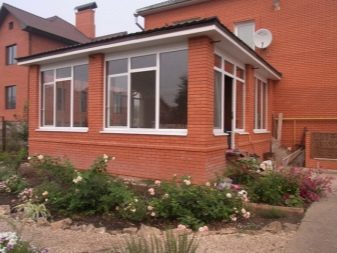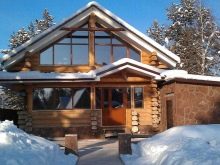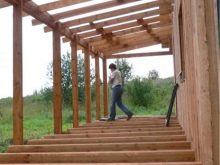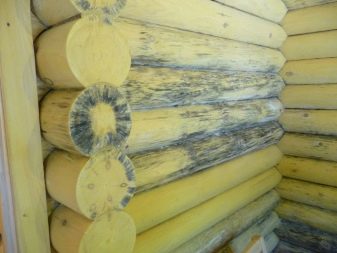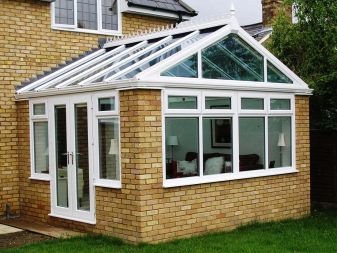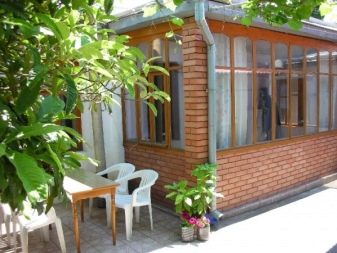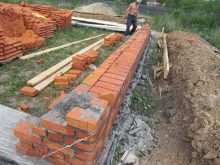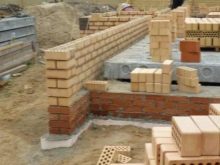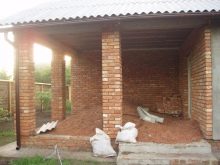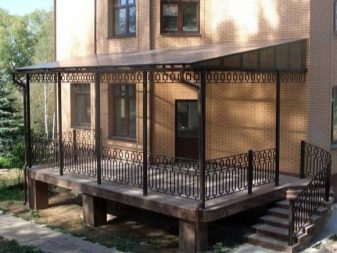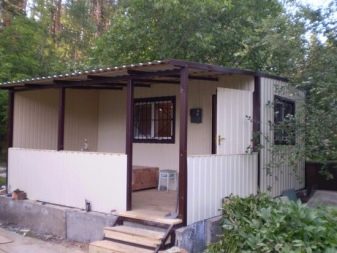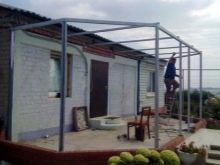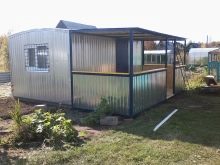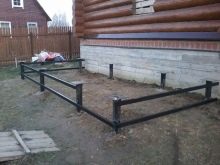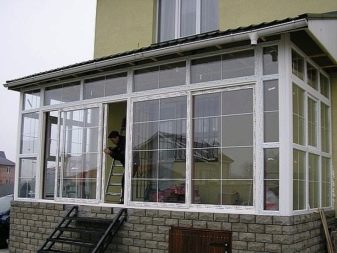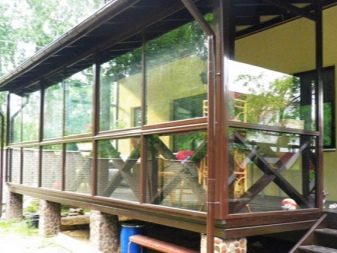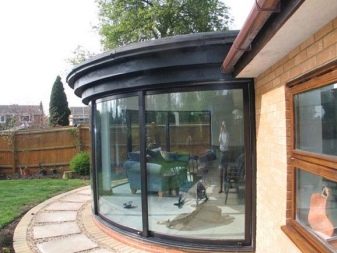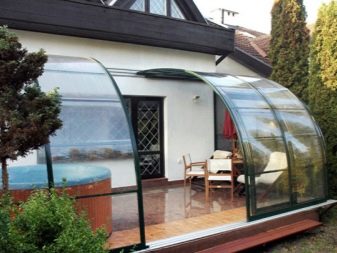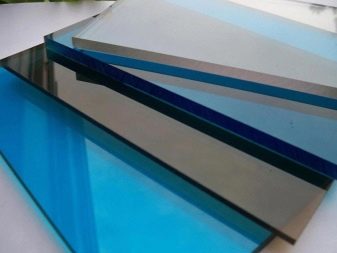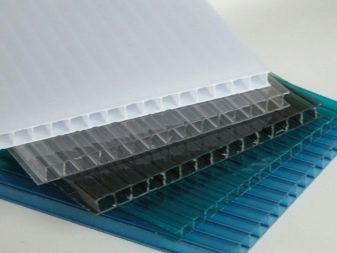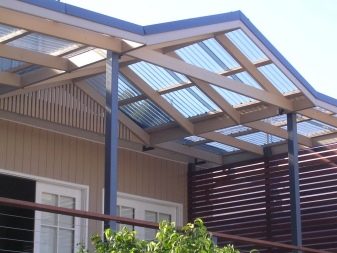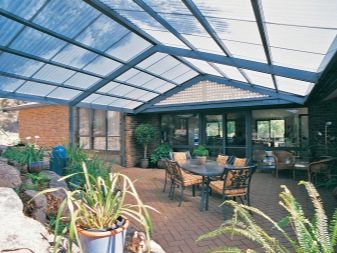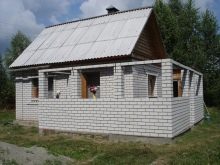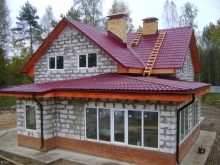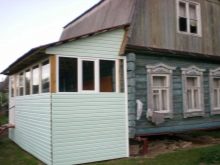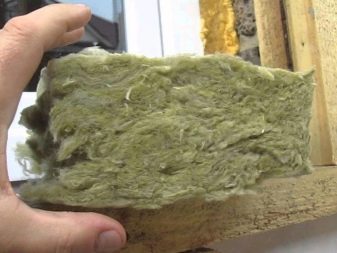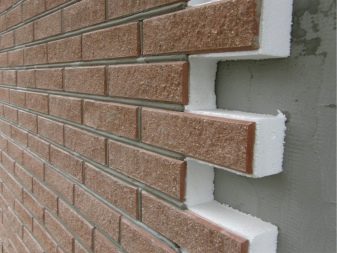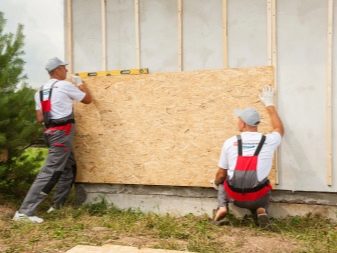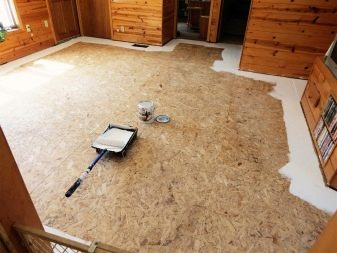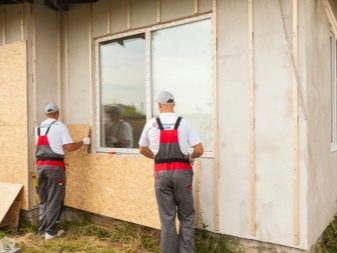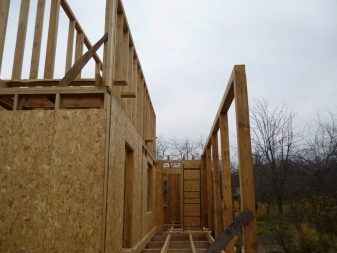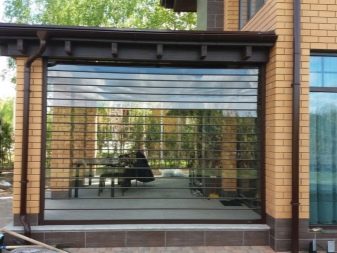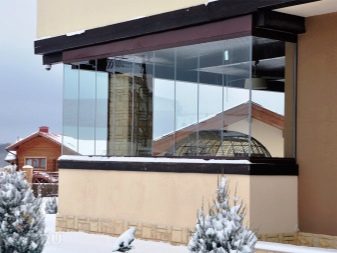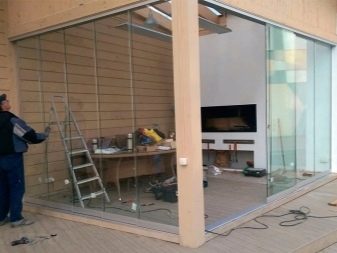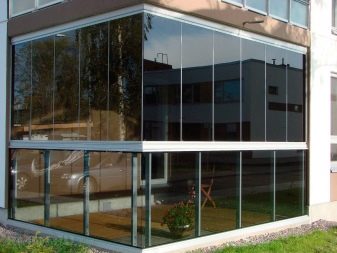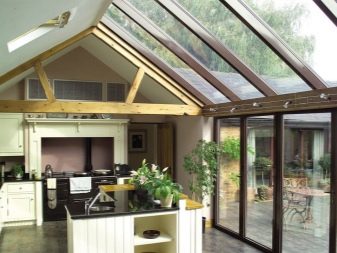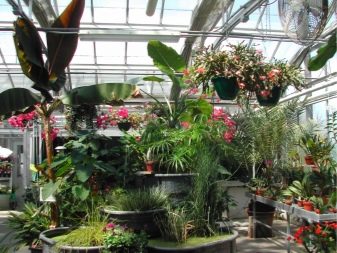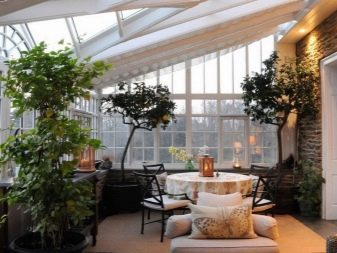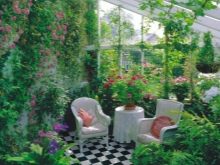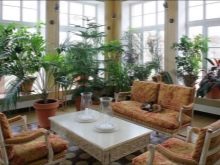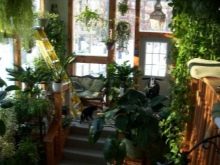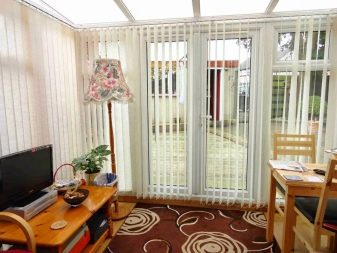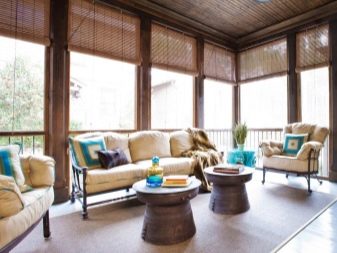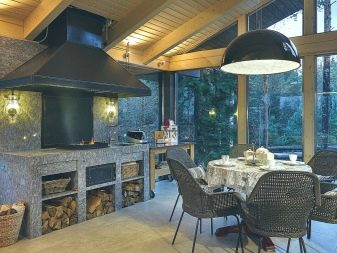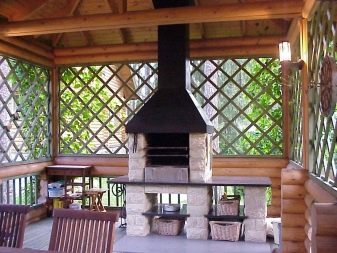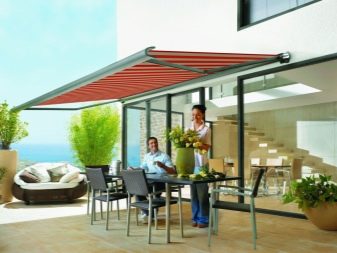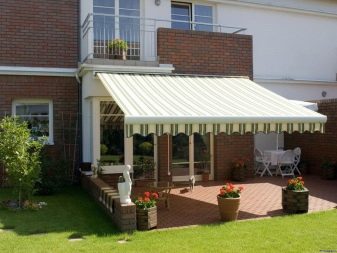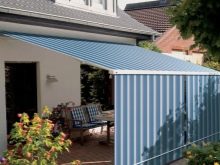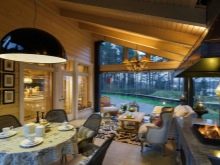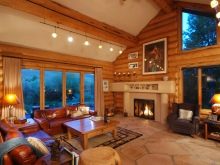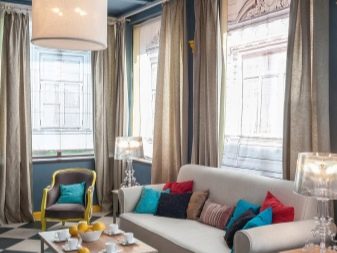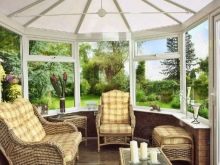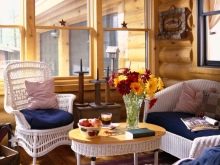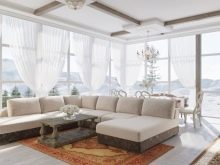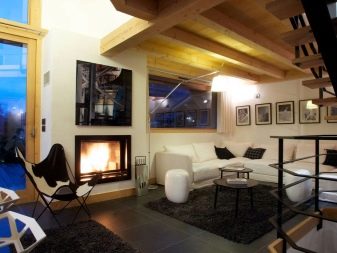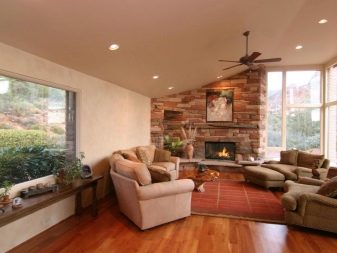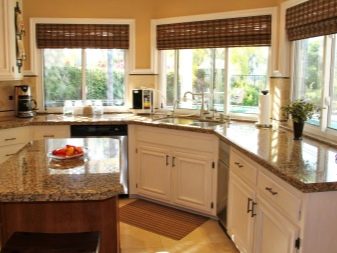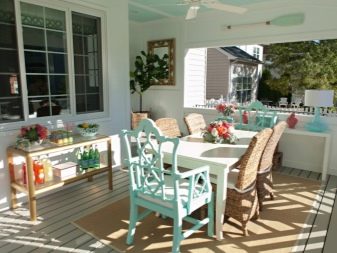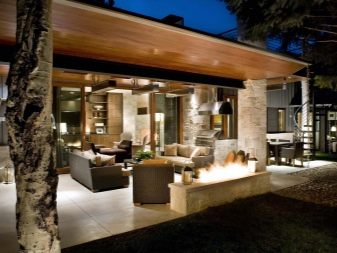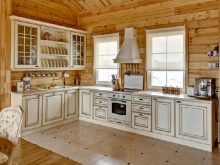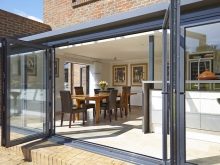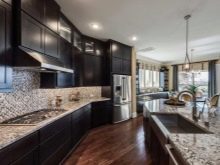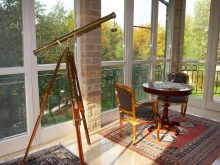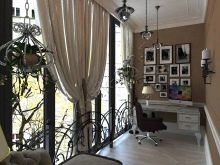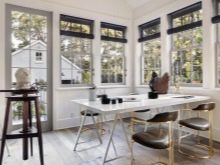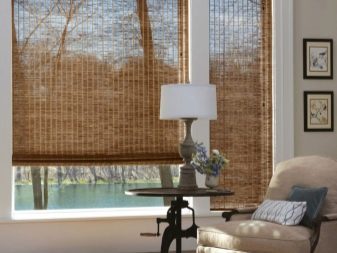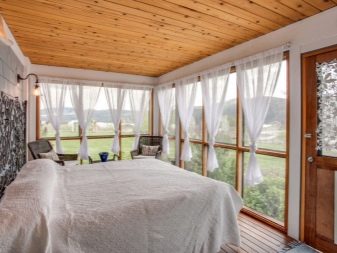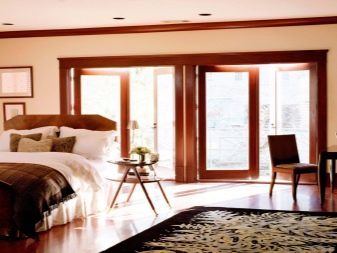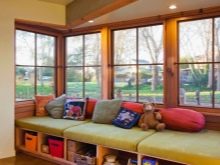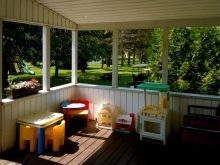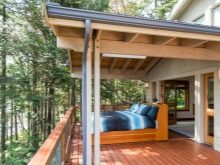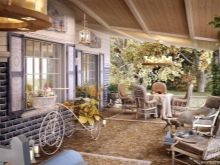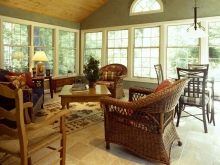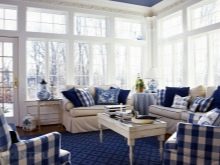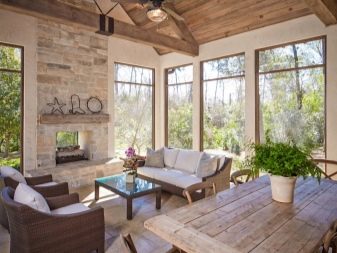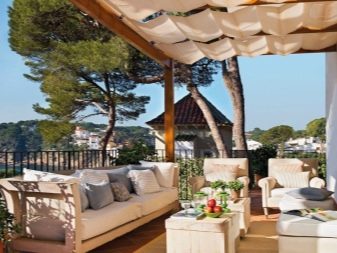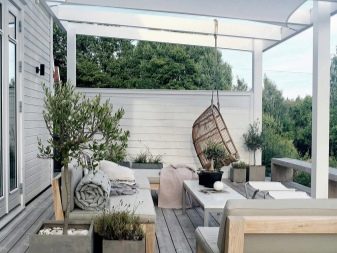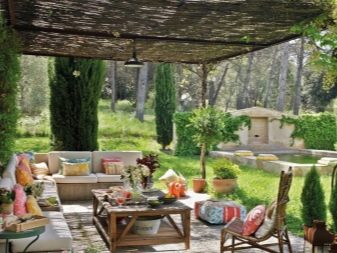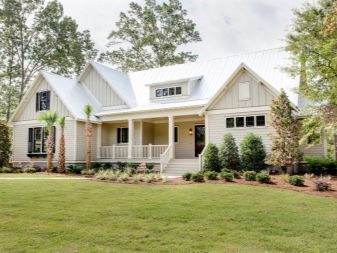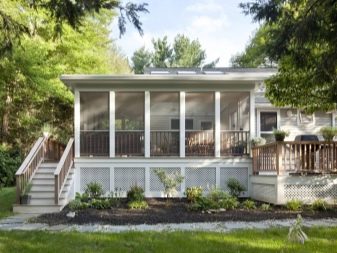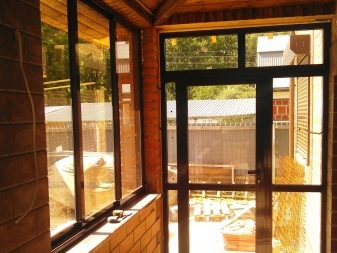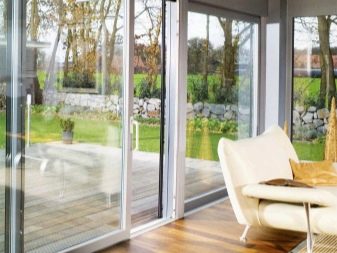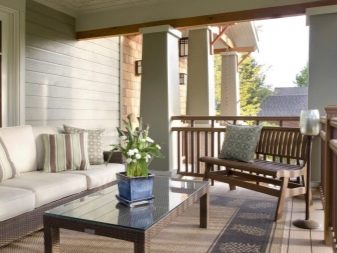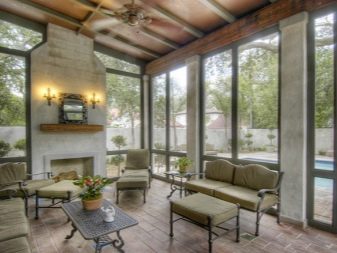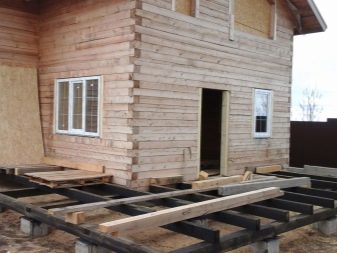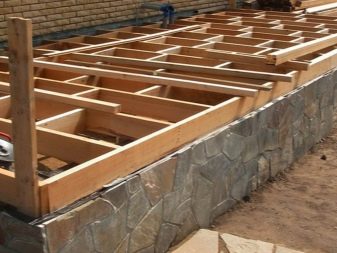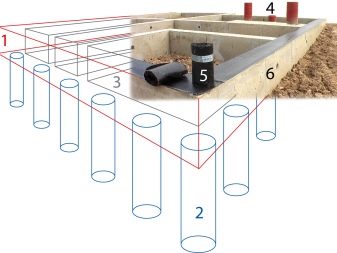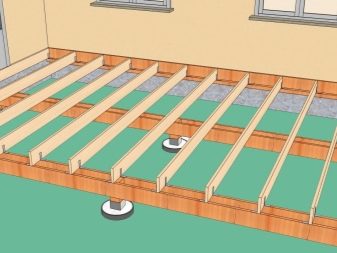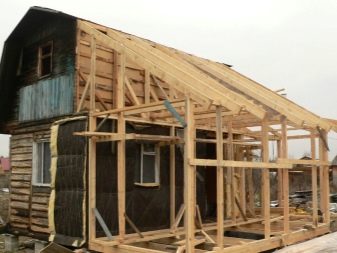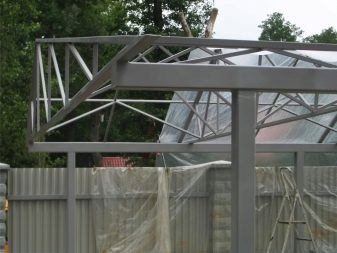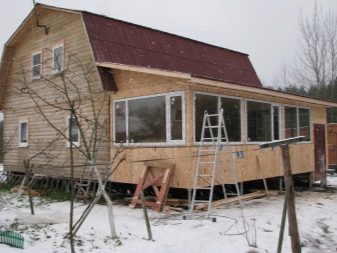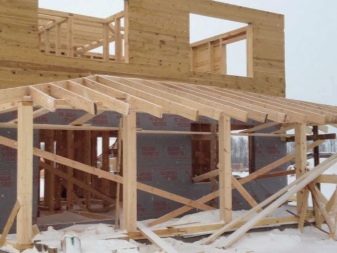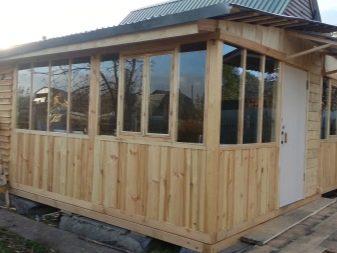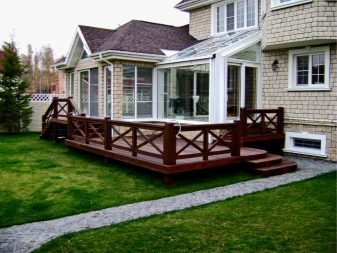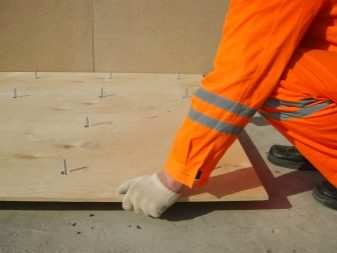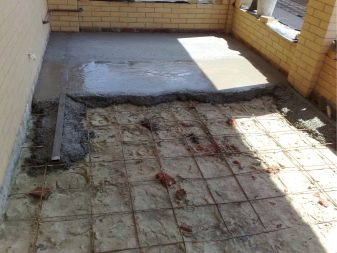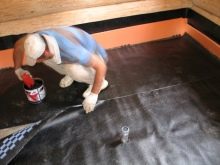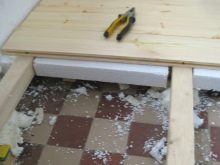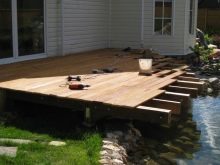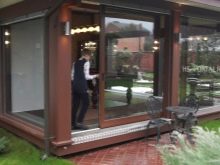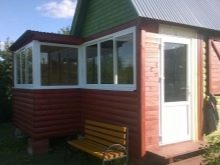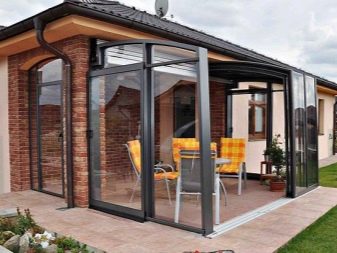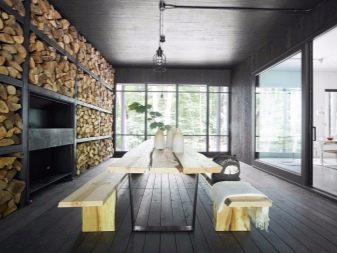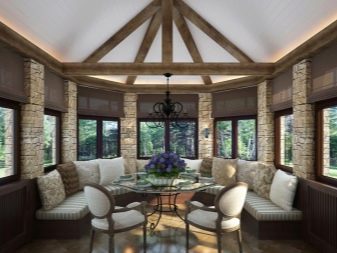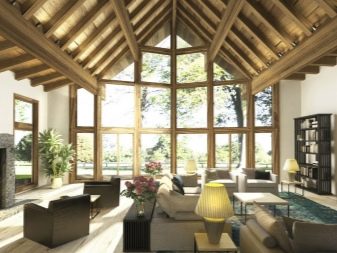Veranda: features and types of designs
The veranda is strikingly different from the terrace. Many do not take into account this fact before choosing a design. They mistakenly believe that this is the same thing, and as a result do not achieve the desired result. Before you decide exactly what you want to see - a veranda or terrace, you need to get acquainted with general information on the topic.
Special features
The veranda is a very special structure erected on the site close to the house. This building is a closed extension to a private house or cottage. Here is the definition given in the SNiP: "The veranda is a glazed unheated room attached to the building or built into it." Therefore, to take any extension as a veranda is a big mistake, since the fact of the glazing of the structure is important here.
Now it is rare to find private houses or villas without a veranda.This is due to its high functionality and decorative qualities.
Veranda performs several purely practical functions:
- insulation of the front part of the house;
- protection of the entrance door against the penetration of the cold wind;
- protects the house from intruders;
- increases sound insulation;
- forms additional space.
The summer veranda is necessarily done without insulation, while the winter version is sometimes supplemented with some improvements, for example, the “warm floor” system. All this guarantees compensation for the difference in temperature between the external environment and inside the house, so there will be no greenhouse effect on the veranda. On top of that, it must be equipped with a ventilation system so that the air circulates better.
Usually verandas are made in a rustic style., but there are exceptions: hi-tech, modern and others. What remains unchanged is the presence of high-quality glazing, as well as the strength of the walls as opposed to the small sides of the open terrace.
Advantages and disadvantages
The veranda is similar to living rooms, except that heating is not provided here.
Accordingly, the advantages of the extension will be similar.
- Protection against atmospheric phenomena. Like a residential room, the veranda guarantees reliable shelter and protection from all kinds of precipitation, scorching sun, and gusts of wind. However, the veranda on occasion will protect not only you, but also the front wall of the building.
- Improvised storage room. If any things are not used for a certain period, but cannot be stored outside, then they can be placed directly on the veranda, where they will lie for the entire time that the extension will not be used.
- Alteration under the full room. This will require a heating and ventilation system with the permission of the relevant authorities, which will expand the total area of its home.
- Unity with nature. Rest on the country porch favorably affects the psychological state of a person, allowing him to relax, forget about problems and stress for a while.
However, there are "pitfalls", which must be remembered.
- Inefficient heating. Veranda will never be a full-fledged room, and therefore there are such difficulties with its heating.The walls will not be insulated enough, so some of the heat will be lost.
- Not always a good view. Part of the view is simply closed by walls, and the windows because of the frames do not allow to evaluate the landscape in all its glory. For many, such inconveniences are considered significant design flaws.
- The need for styling. Veranda need to pick up a house. They should be stylistically combined with each other, ideally made of the same materials.
Difference from the terrace
So, the first and main difference from the terrace is the presence of glazing. A terrace is often called an open veranda, reckoning it as a subcategory of verandas, but in reality these are two completely different designs.
The second factor is that the veranda is necessarily a roof structure.while the terrace may not have a roof at all. Sometimes you can find terraces that completely occupy the whole space between the pool and the exit to it. In the case of verandas you will not see this. The only thing that you can choose in this case is the arrangement of the pool directly on the veranda.
The third difference is the foundation. Veranda can be immediately laid in the plan of the house (by the way, this option is the most preferable), but it can also be attached additionally, and it is desirable to use the same type of foundation as for the main house. In the case of a terrace, the situation is somewhat different: this construction rarely has a common foundation with the house, mainly on columnar bases.
According to the SNiP, the definition of a terrace is as follows: “A terrace is a fenced open extension to a building in the form of a recreation area that can have a roof; is located on the ground or above the floor below. " It is recommended not to confuse the terrace and the veranda, not to take them for similar concepts.
Material selection
The choice of material will depend not only on the appearance of the veranda, but also on its performance. The material largely determines the degree of thermal insulation of the extension, its lightness. Choosing different materials, you can vary the degree of light penetration into the building, the microclimate in it, so you should approach this step deliberately and responsibly.
There are two categories of materials: to create the main walls of the structure and for glazing. The first group is more numerous due to the large number of new materials that were not previously used in the construction of verandas, and now they are being mastered by all in large quantities. Transparent materials at affordable prices is quite small, and therefore there was such an imbalance.
Turning to the question of which of the materials are most in demand in the construction of porches, the answer is obvious - it is wood and brick. They are durable, have good thermal insulation properties, and you can work with them without special training. Even a novice can handle this building.
Tree
Wooden verandas do not lose their relevance. Over the years, this material does not become less popular.
All this is due to several factors.
- The veranda of a log or log house turns cozy in appearance. It looks a bit rustic, but therein lies a special charm.
- Wood can be used not only for cladding, but also in the construction of frame base.
- Even if the veranda is not built of wood, it does not mean that the material can not be used for finishing work. Often you can find interior trim clapboard.Wooden cladding can be used on the walls. The classics of the genre is the floor covered with blackboard.
Wood is environmentally friendly, but it does not have high wear resistance. The material easily swells under the action of high humidity, warps when temperature drops. If you do not take the necessary precautions, then there is a great risk that moss, mold will appear on the wood paneling, or insects will be created in it.
Therefore, after construction it is recommended to additionally cover the walls with several layers of varnish.
Brick
It is rather difficult to find a brick porch without additional insulation. As a rule, such constructions are winter, therefore they are most often later converted to additional rooms. Brick options are not typical for summer houses. Most often they are attached when expanding a private house in which they live on a permanent basis.
Brick has a lot of advantages compared with not very practical wood. If during the construction of a wooden veranda there was a need to wait for about one and a half years until the material was seated, then there is no such need: the brick does not shrink.The veranda can be built in record time, but no need to hurry. It is better to do the job a little slower, but qualitatively.
The brick is used for laying the column foundation. Sometimes the pillars are formed from bricks, resulting in a high-quality and durable base. Working with bricks is somewhat more difficult, but in the end you can get high-quality and good-quality walls that reliably protect against bad weather.
Metal
Do not be discounted and metal buildings. Of course, forged options can be found not so often because of their high cost, but such designs are beautiful, harmonious, light and interesting. If you can not afford to forge, then the alternative is the sheathing of ordinary metal sheets. It is possible to argue about the aesthetic side of such a decision, but it can be carried out in a short time.
More often, metals are used in the construction of the frame, because sometimes it is not possible to make a frame structure of wood (for example, if you plan to sheathe the frame with heavy materials). Metal sheeting can also be used for plating, and they not only draw the walls, but also the roof. Decking is easy to install, but because of its impressive weight, you need the help of a partner.
Piles are made of metal for the foundation, using for this purpose specially treated steel. Screw piles have been particularly widely used when working on heaving, easily crumbling soils.
Polycarbonate
Fans of the unusual will appreciate the buildings made of polycarbonate. The material is a large panel, reminiscent of glass due to transparency, but more reliable and strong.
In fact, polycarbonate is a heavy-duty plastic that is not afraid of environmental influences and has some important qualities.
There are two types of material: monolithic and cellular. Monolithic polycarbonate is more expensive because it is almost transparent and most of all resembles glass. Solidity allows you to give the material anti-vandal characteristics. He is not beating, but only deformed by the impact of strong blows.
The cellular variant is cheaper because it requires less raw materials to be used. Due to the cellular structure, it has enhanced thermal insulation characteristics, and when arranging a summer terrace, you will not have to worry about the temperature on the terrace in winter.It will be 10-12 degrees higher than on the street. Polycarbonate is produced in a wide variety of colors. There are opaque, translucent and matte panels.
Aerated concrete and foam blocks
New development, allowing to build a verandah for a few days, are block materials. The differences between the aerated concrete structures and foam blocks are insignificant and almost imperceptible, so it makes no sense to dwell on them.
The construction process is expressed in the following. A construction of blocks is erected, after which a concrete solution is poured inside the wall, which is left to solidify. After that, you can proceed to the rest of the finish - the walls are ready.
It is important to remember about the obligatory presence of any facade cladding: siding, "block house", panels, tiles.
The walls of these materials are well insulated, and there are many ways to insulate them. They use both films and panel insulation according to the type of mineral wool and the like.
With all the speed of construction, the quality will not suffer. And the strength of the walls, and their heat-saving functions are at a high enough level, while the material is lightweight, which allows not to overload the base.The only negative is the relative high cost of the material, as well as the need to install additional protective panels for the facade.
Oriented strand board (OSB)
Sheets of RSD are used for covering frameworks, while they are not used as a finishing coating. This is due to poor decorative properties: oriented strand boards do not look very attractive. The material is a board of glued compacted sawdust, so its appearance leaves much to be desired.
The panels have a number of advantages, including low cost of material, excellent performance, high resistance to mechanical stress. So, OSB is hard to break. There are several classes, starting with the first and ending with the fourth, and the latter is designed for operation in adverse conditions with high humidity.
However, the material has important disadvantages. They can not sheathe the veranda, if it is planned for some time to live. The fact is that the composition of the glue for RSD includes toxic substances that, evaporating, poison the body.Also, the material does not breathe, which is why the air circulation in the room can be disturbed.
Glazing Materials
For glazing the veranda has long been used not only the notorious glass. It is becoming a thing of the past, giving way to more modern and technological materials. These include so-called PVC blinds or transparent roller blinds. They are a soft elastic film, which is stretched in the places of window openings. Such a film, if desired, can be dismantled, turning the veranda into a terrace. Do not be afraid of kinks that occur when folding PVC. As a rule, within several days they are completely smoothed.
Also, as the windows are used monolithic polycarbonate panels of the highest quality. It is transparent, so you are guaranteed to have a beautiful view of the surrounding situation. Caring for polycarbonate windows is easy to implement, as they are not afraid of physical impact. If they are very dirty, they can be washed with Karcher.
In a large variety of materials it is easy to get lost, but if you know exactly what kind of result you need to get, the choice will be obvious.The main thing is that the purchased materials were of high quality, and the installation was carried out in compliance with all the rules.
Arrangement
There are many options for how you can equip the veranda. Among the most popular solutions is the addition of an extension under the conservatory or conservatory. Indeed, this will give the flowers and other plants the best conditions for their growth and flowering, as with proper equipment it will be possible to regulate the temperature.
An unusual view of the veranda is given by the blinds on the windows, especially the panoramic options. It’s much more common to see a veranda with curtains, but the blinds are more convenient in functional terms: they are not so dirty and better protect from the sun. It is best to equip a summer extension building made of foam blocks, on which a circle of friends will gather, with accessories for improving rest: a brazier, a barbecue.
You can simply put a fireplace here to give the atmosphere of comfort and warmth.
An interesting solution is to protect the entrance to the veranda with a canopy. Particularly popular canopies such as "Marquis" due to their elegant appearance. However, sheds are more suitable for terraces, but not for glazed extensions.Special attention deserves the lighting device. An excellent choice would be flat lamps, which do not take up much space, but at the same time allow you to fully illuminate all the space.
Alteration of the veranda under the living room is a special topic.worthy of separate discussion. So, each room-veranda is unique, so it makes sense to discuss each option separately.
Veranda living room
In most cases, the veranda is taken exactly under the living room. It is nice to gather here with the whole family, discuss the latest news over a cup of tea, or just wait out the bad weather while laughing and having fun. This causes a minimal set of furniture: a sofa, a few chairs, soft chairs or poufs, a small table. In drawing up an ensemble of furniture, be guided not only by how harmoniously it fits into the interior in the future, but also by the needs of all family members.
However, it is the stylistic unity that is important, because the feeling of comfort, the desire to be on the veranda, to spend time here, to build communications depends on how harmonious the whole atmosphere is. The presence of a fireplace is a constant component of a cozy atmosphere.Additionally, an improvised living room can be supplemented with some pleasant trifles: window curtains, potted plants. All this will make the situation even more comfortable. It is also important to ensure that there are no drafts in the room.
Veranda kitchen
Arrangement of the veranda under the kitchen or dining room is not quite typical. This is due to the fact that certain difficulties arise when there is a need to carry out an extension of the water supply system and install sewers. Such work should be planned and taken into account even at the stage of filling the foundation, otherwise the implementation of drainage and water pipelines will become troublesome and expensive.
If the veranda is equipped with a full-fledged kitchen, then you need to think about exactly how the kitchen side dish will be located. It is usually placed close to the window in order to provide maximum light access to the working surfaces. In addition, artificial lighting is arranged above them in order to be able to cook even after sunset. When arranging the dining room, the question arises only about the placement of the table and chairs, as well as cabinets for dishes, if their presence is provided.It will be useful to purchase a variety of textile knick-knacks that will give the space a special homely atmosphere.
Veranda room
If the veranda is attached to a cottage or a private house, then it is not surprising that the owners will one day come to mind the idea of using it as a workspace. You won't need much for this: you just need to put a desk, a chair and several shelves for working papers, if you keep them at home. A large amount of natural light guarantees a productive working day, and if you like to work at night, then arrange for yourself several sources of artificial lighting.
An important condition will be good noise insulation. The cries of children, the barking of a dog, the screeching of tires of a passing car - all this can easily knock down the working attitude and deprive a person of concentration. To avoid this, it is necessary to take action. Equip the window blinds, for example, on the remote control, so that if necessary, "close" from the whole world. Pay attention that purple tones are the best to tune in to work, but classic brown shades of wood will cope with this role.worse.
Veranda-bedroom or veranda-nursery
Here opens almost unlimited space for fantasy. So, the bedroom can be both summer and for year-round living, but only on the condition that you agree with the responsible authorities on the alteration of the veranda into a full-fledged living room. However, it is not worthwhile to organize a year-round nursery here: the risk that children will catch a cold is too great.
If you plan a seasonal child, you must provide the wishes of the child. For example, if he will use the veranda only for games, and sleep elsewhere, then you can install a pool with balls, a wall bars and similar shells. If the veranda serves as a baby and also a bedroom, then his bed needs to be thought out to the smallest detail. An interesting idea is to stylize the bed, turning it into another object, for example, into a princess's house or a car. For an adult bedroom, you can only confine yourself to a bed, a bedside table and a wardrobe. Unnecessary items here is better not to post.
Style
Veranda can not be issued in any style. For this purpose, mainly simple, village destinations, such as Provence or Country, are suitable.The Mediterranean-style setting will look great here, since its specific features are a large number of fresh white and blue hues, deliberate negligence, plenty of free spaces. Mediterranean style involves the use of plants in large quantities. It is important to follow the shade: if the room is located on the north side, then a warm color scheme will do, if on the south it is cool.
Interesting here will look all sorts of ethnic motifs. Eastern, ecological, Scandinavian directions will allow to make the veranda the center of the overall design concept, while correctly integrating it into the overall situation, so that its interior is in harmony with the interior of the whole house. Decorations on the walls, such as paintings, tapestries, photographs, will look good. They add comfort no matter what style is chosen.
Designs
The design of the veranda may consist of various elements. Among them are both mandatory and those that can be easily abandoned.A large role is played by what material the veranda is built from, by which it is sheathed, which one it is - winter or summer. For example, an extension, lined with aluminum siding profile, will require the presence of additional decorative elements: a porch with a railing, a visor, beautiful shutters that will brighten up a dull gray look of decoration.
It also plays the role of how the veranda is located relative to the entrance door. For example, if a person enters from it immediately into the hall, hallway, hallway of the house, then it is impossible to place the porch door opposite the door to the house - a draft will arise. If, however, from the veranda they enter a platform with a staircase separated from the main rooms by a partition, or into a vestibule, then the placement of the door will not play any role.
A small veranda does not always allow for the presence of a porch, canopies and other details, as in such a pile it will seem even smaller than it actually is. In such cases, they discard unnecessary elements, at the same time resorting to methods of visually increasing the space: they make the ceiling light, the floor is dark, and a vertical strip pattern is placed on the walls.
Foundation
The basic rule is that a foundation of the same type should be used for the main house and the veranda. In some cases, compliance with this requirement is impossible, and then it is considered acceptable that the bases are only the same in height and appearance.
Most often for the verandas choose the foundation of the combined type - tape-column. It is easy to make yourself, moreover, it perfectly maintains the extension. The construction of such a foundation does not take much time, but it is quite labor-intensive.
Another alternative is a column foundation.Which is chosen by experienced craftsmen. Great complexity is caused by the equipment of the floor on such a basis, but here the floor is well ventilated. In combination with such a foundation, it is easiest to organize the “warm floor” system. Whatever your choice, remember that the secret of success lies in the correct layout and the choice of the depth of the foundation.
Frame
The framework can be erected from wooden beams or from a metal profile. Both options are equally popular.It all depends on what you plan to revet the walls. If the lining material is heavy, then a metal frame will do, and if lightweight, then wooden. Another factor is the compatibility of the materials. For example, lightweight aluminum siding should not be fixed to wooden frames. It would be much better to use metal for these purposes.
The frame of the veranda should be closely fitted to the walls of the main building., since the presence of gaps and, therefore, drafts and precipitation penetration into the gap between the facade and the veranda depends on this. The design of the frame must be strong so that it could later withstand the weight of the roof along with the roofing frame. In the case of verandas, it will be made mostly of wood, and it does not matter which frame was used for the walls.
Roof
Traditionally, for the verandahs adjacent to the façade with their long side, single-pitch roofs are used, even if completely different forms were used for the house. The roof of this form is easy to care for. The single-pitch construction looks more harmonious on adjacent structures.
The slope angle is selected according to the climatic conditions, making special calculations.
Quite another thing is the veranda adjoining the house butt, namely its narrow part.Then a long and narrow lean-to roof will look strange and not very attractive. In this case, gable roofs of simple construction are chosen, and usually professionals are hired to assemble such a roof. Only they can fit the double-slope roof in the existing roof.
As for the materials, they can be any. To preserve stylistic unity, choose the same roofing material that was used for the main house.
Floor
The flooring is usually made of wood. Most often the draft floor is upholstered with plywood or the floors are immediately made of OSB-panels. Another elementary option is a concrete floor. All that is required is to perform a high-quality coupler, and a flat surface will serve as a beautiful floor for a summer terrace. Winter option will need to be further warmed.
In order not to spend a lot of time on concrete warming, you can simply lay linoleum. Depending on the classiness, it can be immediately warmed material, under which you do not need to additionally prepare a concrete base: just lay enough linoleum. The same applies to rubber mosaic coatings, the main requirement of which is a flat floor.Returning to the topic of wooden options, it is worth mentioning the decking, which looks like an ordinary shipboard, just laid out in mosaic.
Doors and windows
The door can be any. If the owner wishes, it can generally be abandoned by using sliding glass panels to close the doorway. This option is only suitable for houses in which they live permanently, since such a design will result in several attempts at robbery. The windows are best decorated with plastic panels or soft curtains.
Interior and facade: beautiful examples
Soft PVC curtains can be used as panoramic windows, but this approach cannot be used in harsh climatic conditions. Similar verandas are permissible only in the southern regions of our country.
The porch-dining room, furnished in a loft style, has retained the urban spirit of style. But it does not seem gloomy and repulsive. On the contrary, the storehouse of firewood and the fireplace give it a homely appearance, as a result of which the most pleasant emotions arise in such an extension.
For chalet style, the use of glazing is uncharacteristic. Usually in such houses are equipped with terraces.Important elements of the style is the abundance of natural materials: stone, wood, animal skins.
The front porch can be turned into a full room, but you need to be ready to spend a lot of money for this. We'll have to draw up the paper, to engage in warming, arranging heating and fitting the new “room” to the house, to spend here all the benefits of civilization: electricity, plumbing and sewage, if they are needed.
How to build a successful porch, see the following video.

